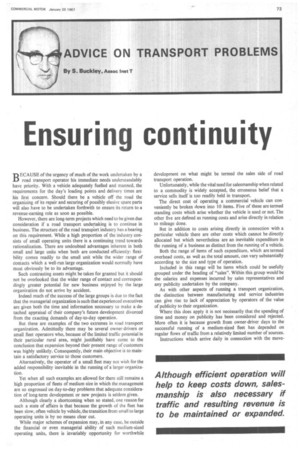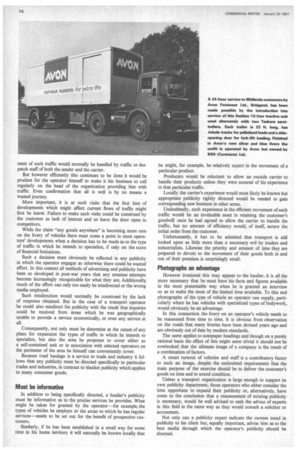Ensuring continuity
Page 75

Page 76

If you've noticed an error in this article please click here to report it so we can fix it.
BECAUSE of the urgency of much of the work undertaken by a road transport operator his immediate needs understandably have priority. With a vehicle adequately fuelled and manned, the requirements for the day's loading points and delivery times are his first concern. Should there be a vehicle off the road the organizing of its repair and securing of possibly elusive spare parts will also have to be undertaken forthwith to ensure its return to a revenue-earning role as soon as possible.
However, there are long-term projects which need to be given due consideration if a road transport undertaking is to continue in business. The structure of the road transpOrt industry has a bearing on this requirement. While a high proportion of the industry consists of small operating units there is a continuing trend towards rationalization. There are undoubted advantages inherent in both small and large units when both are conducted efficiently: flexibility comes readily to the small unit while the wider range of contacts which a well-run large organization would normally have must obviously be to its advantage.
Such contrasting assets might be taken for granted but it should not be overlooked that the wider range of contact and correspondingly greater potential for new business enjoyed by the large organization do not arrive by accident.
Indeed much of the success of the large groups is due to the fact that the managerial organization is such that experienced executives are given both the time and information necessary to make a detached appraisal of their company's future development divorced from the exacting demands of day-to-day operation.
But these are examples of the two extremes in road transport organization. Admittedly there may be several owner-drivers or small fleet operators who, because of the limited traffic potential in their particular rural area, might justifiably have come to the conclusion that expansion beyond their present range of customers was highly unlikely. Consequently, their main objective is to maintain a satisfactory service to those customers.
Alternatively, the operator of a small fleet may not wish for the added responsibility inevitable in the running of a larger organization.
Yet when all such examples are allowed for there still remains a high proportion of fleets of medium size in which the management are so engrossed on day-to-day problems that adequate consideration of long-term development or new projects is seldom given.
Although clearly a shortcoming when so stated, one reason for such a state of affairs is that because the growth of the fleet has been slow, often vehicle by vehicle, the transition from small to large operating units is by no means clear cut.
While major schemes of expansion may, in any ease, be outside the financial or even managerial ability of such medium-sized operating units, there is invariably opportunity for worthwhile development on what might be termed the sales side of road transport operation.
Unfortunately, while the vital need for salesmanship when related to a commodity is widely accepted, the erroneous belief that a service sells itself is too readily held in transport.
The direct cost of operating a commercial vehicle can conveniently be broken down into 10 items. Five of these are termed standing costs which arise whether the vehicle is used or not. The other five are defined as running costs and arise directly in relation to mileage done.
But in addition to costs arising directly in connection with a particular vehicle there are other costs which cannot be directly allocated but which nevertheless are an inevitable expenditure in the running of a business as distinct from the running of a vehicle.
Both the range of items of such expenditure, which are termed overhead costs, as well as the total amount, can vary substantially according to the size and type of operation.
Included in this range will be items which could be usefully grouped under the heading of "sales". Within this group would be the salaries and expenses incurred by sales representatives and any publicity undertaken by the company.
As with other aspects of running a transport organization, the distinction between manufacturing and service industries can give rise to lack of appreciation by operators of the value of publicity to their organization.
Where this does apply it is not necessarily that the spending of time and money on publicity has been considered and rejected. More often it is because growth from owner-driver days to the successful running of a medium-sized fleet has depended on regular flows of traffic from a relatively limited number of sources.
Instructions which arrive daily in connection with the move ment of such traffic would normally be handled by traffic or despatch staff of both the sender and the carrier.
But however efficiently this continues to be done it would be prudent for the operator himself to make it his business to call regularly on the head of the organization providing him with traffic. Even confirmation that all is well is by no means a wasted journey.
More important, it is at such visits that the first hint of developments which might affect current flows of traffic might first be learnt. Failure to make such visits could be construed by the customer as lack of interest and so leave the door open to competitors.
While the claim "any goods anywhere" is becoming more rare on the livery of vehicles there must come a point in most operators' developments when a decision has to be made as to the type of traffic in which he intends to specialize, if only on the score of financial limitations.
Such a decision must obviously be reflected in any publicity in which the operator engages as otherwise there could be wasted effort. In this context all methods of advertising and publicity have been so developed in post-war years that any amateur attempts become increasingly recognizable for what they are. Additionally, much of the effort can only too easily be misdirected or the wrong media employed.
Such misdirection would normally be construed by the lack of response obtained. But in the case of a transport operator he could also misdirect his publicity with the result that inquiries could be received from areas which he was geographically unable to provide a service economically, or even any service at all.
Consequently, not only must he determine at the outset of any plans for expansion the types of traffic in which he intends to specialize, but also the area he proposes to cover either as a self-contained unit or in association with selected operators on the perimeter of the area he himself can conveniently cover.
Because road haulage is a service to trade and industry it follows that any publicity must be directed specifically to particular trades and industries, in contrast to blanket publicity which applies to many consumer goods.
Must be informative In addition to being specifically directed, a haulier's publicity must be informative as to the precise services he provides. What might be taken for granted by the operator—for example, the types of vehicles he employs or the areas to which he has regular services—needs to be set out for the benefit of prospective customers.
Similarly, if he has been established in a small way for some time in his home territory it will naturally be known locally that he might, for example, be relatively expert in the movement of a particular product.
Producers would be reluctant to allow an outside carrier to handle their products unless they were assured of his experience in that particular traffic.
Locally the carrier's experience would most likely be known but appropriate publicity rightly directed would be needed to gain corresponding new business in other areas.
Undoubtedly, such experience in the efficient movement of such traffic would be an invaluable asset in retaining the customer's goodwill once he had agreed to allow the carrier to handle the traffic, but no amount of efficiency would, of itself, secure the initial order from the customer.
Unfortunately, it has to be admitted that transport is still looked upon as little more than a necessary evil by traders and industrialists. Likewise the priority and amount of time they are prepared to devote to the movement of their goods both in and out of their premises is surprisingly small.
Photographs an advantage However irrational this may appear to the haulier, it is all the more necessary that he must have his facts and figures available in the most presentable way when he is granted an interview so as to make the most of the limited time available. To this end photographs of the type of vehicle an operator can supply, particularly where he has vehicles with specialized types of bodywork, would obviously be an advantage.
In this connection the livery on an operator's vehicle needs to be reassessed from time to time. It is obvious from observation on the roads that many liveries have been devised years ago and are obviously out of date by modern standards.
The same applies to notepaper headings and though on a purely rational basis the effect of this might seem trivial it should not be overlooked that the ultimate image of a company is the result of a combination of factors.
A smart turnout of vehicles and staff is a contributory factor to such an image, despite the undoubted requirements that the main purpose of the exercise should be to deliver the customer's goods on time and in sound condition.
Unless a transport organization is large enough to support its own publicity department, those operators who either consider the time opportune to expand their publicity or, alternatively, have come to the conclusion that a reassessment of existing publicity is necessary, would be well advised to seek the advice of experts in this field in the same way as they would consult a solicitor or accountant.
Not only can a publicity expert indicate the current trend in publicity to his client but, equally important, advise him as to the best media through which the operator's publicity should be directed.




























































































































